There are six pipits (Anthus spp.) on the Malaysian list. Of these, only Paddyfield Pipit is resident. The others are either more or less regular but localised non-breeding visitors (Olive-backed Pipit and Red-throated Pipit), scarce migrants (Pechora Pipit – Bornean Malaysia only – and Richard’s Pipit) or vagrants (Blyth’s Pipit – Peninsular Malaysia only).
The pipits can be fairly reliably grouped according to their preferred habitat in Malaysia: Paddyfield, Richard’s, Blyth’s and Red-throated are lowland open country birds; Olive-backed occurs mostly at montane and submontane altitudes and in more forested habitats; and Pechora has a predominantly coastal distribution in northern Borneo, preferring coastal scrub.
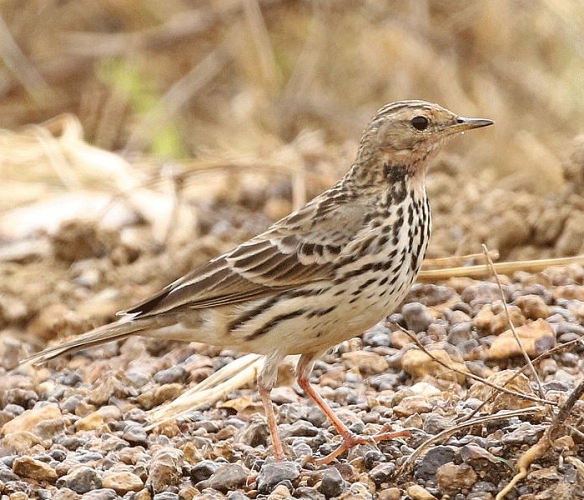
Red-throated Pipits usually show at least some pinkish colouration on the throat. Even when they lack this, they differ from the larger pipits by the heavier streaking on the underparts which extends all the way down the flanks, and by the more heavily streaked upperparts.
In this article, I will focus on differentiating the three ‘larger’ species – Paddyfield, Richard’s and Blyth’s (in fact, size differences are small, and there is overlap in length with the so-called ‘smaller pipit’species, but ‘larger pipits’ differ in having proportionally longer legs and a stockier structure).
STATUS
Paddyfield Pipit is the default pipit species in Malaysia, being extremely common in a range of open country habitats.
Richard’s Pipit is at best a scarce non-breeding visitor. Because the resident Paddyfield Pipit was formerly lumped with Richard’s Pipit, the historical status of the species is unclear. In Peninsular Malaysia, the first acceptable record was at Chuping, Perlis, as recently as 2013. Since then, it has been recorded annually at the site between Nov and Feb, but nowhere else in the Peninsula. On Borneo, it is probably a scarce migrant, but well-documented records are few and far between.
Blyth’s Pipit has been recorded just twice; once at Chuping, Perlis, in Jan 2010, and once at Malim Nawar, in Jan/Feb 2017.
HABITAT PREFERENCE
Paddyfield Pipits frequent open grass fields, roadside verges and sandy tracks, and cleared ground with little or no vegetation.
Richard’s Pipits at Chuping prefer much longer grass and more overgrown fallow fields than Paddyfield Pipits. They are rarely flushed from the roadsides there, and are very difficult to see on the ground because of the thicker ground cover they frequent.
Both Blyth’s Pipits were originally observed on sandy tracks, and subsequently fed on short grassy verges, frequently associating with Paddyfield Pipits, and apparently sharing their preferred habitat.
CALLS
It may seem strange to talk about what the larger pipits sound like before what they look like, but, more often than not, it is the call which gives the first clue that we are dealing with something other than a Paddyfield Pipit.
Pipits are generally rather vocal, particularly when flushed or in flight. It is also true that the larger pipits use more than one type of vocalisation, so it is well worth paying attention to the full range of calls made.
As is so often the case, the key to finding a rare species is to make every effort to become familiar with the common ones. Recording and noting down the various calls uttered by Paddyfield Pipits is essential foundational work for anyone with an interest in locating Richard’s or Blyth’s Pipits. Xeno-Canto Asia has an excellent library of bird sounds where you can gen up on the vocalisations of all three species.
Paddyfield Pipits utter a variety of short, sharp calls, many of which sound like “chup” or “chip” to my ears (listen to this and this).
Richard’s Pipits commonly utter an explosive “schreep“(listen here), which is very different from any Paddyfield Pipit call (be careful not to confuse it with the softer, thinner “tseep” of Eastern Yellow Wagtail). I’ve quite often seen Richard’s Pipits near dusk at Chuping as they’ve flown overhead going to roost, calling loudly.
Both Malaysian Blyth’s Pipits were initially located by call. Neither time did I recognise the call as Blyth’s, but both times I knew it was something different and worth investigating. It sounds more buzzy and ‘jangly’ than Paddyfield or Richard’s. Listen here. However, some of the calls sound more Paddyfield-like (such as this one), so don’t be too quick to discount a funny pipit which sounds like a Paddyfield!
PLUMAGE AND STRUCTURE
Paddyfield Pipit

Paddyfield Pipit in alert posture. Paddyfield Pipits typically look 1) short-tailed 2)show dark lores and 3) richly-coloured ear coverts which are obviously darker than the area surrounding them, creating the impression of a cheek patch. 4) The upper parts and crown are not distinctly streaked.5) The head seems proportionally rather large and wedge-shaped, with a flattish crown.

Colour tones may vary according to the light, background colour, and extent of feather wear. Nevertheless, the features mentioned above usually hold true. Some birds show light streaking on the rear flanks (centre photo), while others have unstreaked rear flanks. 6) The bill appears long and relatively thin. 7) The median coverts usually show broad buff edges and dark brown centres when fresh. When worn, they are medium brown with slightly paler edges.

Typically, Paddyfield Pipits show 8) quite heavy breast streaks, and 9) there is usually some contrast between the buffier background colour of the breast and flanks, and the paler lower breast and belly.

Once in a while, variations show up. This bird had pale lores and looked paler overall. However, the bill and head look right for Paddyfield Pipit.
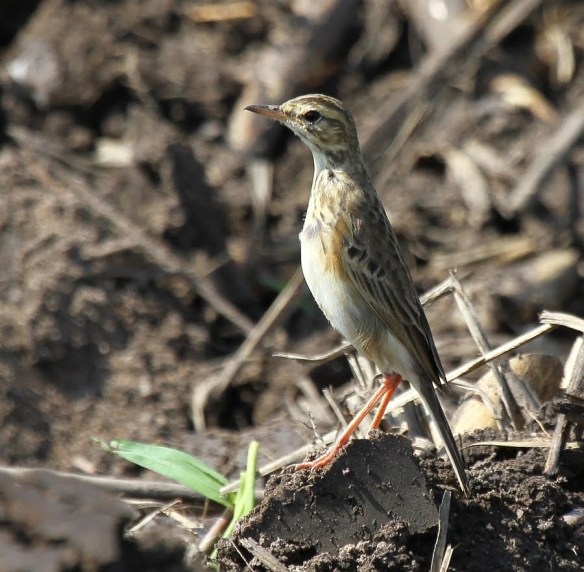
This fresh-plumaged bird appeared much buffier overall than typical Paddyfield Pipits. It appears quite strong-billed, has strongly-patterned median and greater coverts and a dark lateral crown stripe. Some of these features fit Richard’s Pipit. Nevertheless, the overall structure (short-looking tail, not especially long legs) and head pattern (dark lores and ear coverts) seem to fit Paddyfield Pipit best.
Some of these trickier individuals show that identification is not always straightforward, based purely on plumage features. It is always worth taking time to make a thorough appraisal of atypical birds, getting as many photos as possible, and recording the call if this is possible.
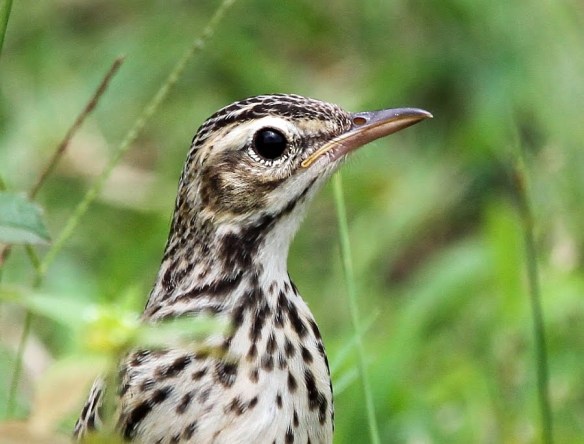
Juvenile Paddyfield Pipits are more distinctly-marked than adults, but their markings do not closely resemble any other species. Besides, there’s usually an adult or two around!
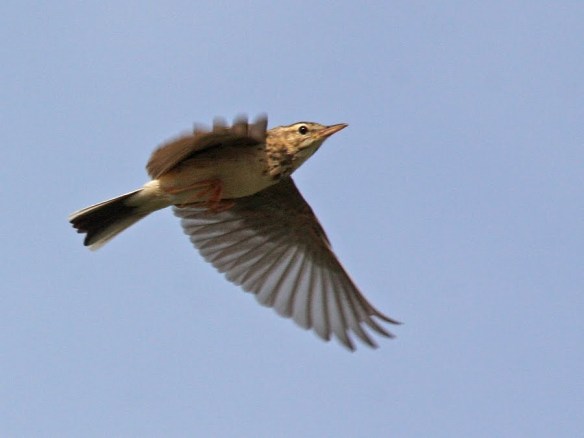
In flight, Paddyfield Pipits look short-tailed. They usually call frequently when in flight. Some books mention that Richard’s Pipits characteristically dangle their feet in flight, and hover before landing. As these habits are commonly observed in Paddyfield Pipits, I don’t think they are of any value for identification.
Richard’s Pipit

Richard’s Pipits are 1) larger than the other two species, sometimes markedly so. Structurally, they are 2) the longest-tailed and -legged of the three. 3) The overall colour is warmer and buffier than is typical of Paddyfield Pipits.

4) The bill is strong with an evenly-curved culmen. 5) The lores are typically pale, as are the lower ear coverts, which result in a more ‘open’ facial expression than Paddyfield. Their preference for long grass can make them difficult to observe on the ground.

6) The crown is rounder (the head is less wedge-shaped) than Paddyfield, and 7) is typically more distinctly-streaked.8) The breast-streaking is less dense than on most Paddyfield Pipits.

The plain-faced appearance, caused by pale lores and lower ear coverts, is striking on this bird. This individual has moulted out its median coverts. The rear flanks are lightly streaked.
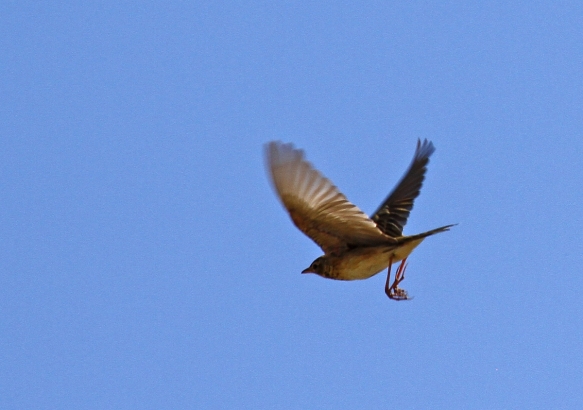
In flight, they look a much stockier, bigger bird than Paddyfield Pipit, and the difference in tail length is obvious. The heavy bill and extremely long hind-claw are also evident in these pictures.
Blyth’s Pipit

From a distance, 1) the pale buff plumage, 2) well streaked mantle and crown, and 3) blackish-centred, whitish-tipped median coverts stand out. 4) The bill looks short and 5) the head seems small and rounded.

6) The pale lores coupled with 7) the relatively weak face pattern (pointed supercilium, pale ear coverts and indistinct moustachial stripe) create an ‘open-faced’ expression.
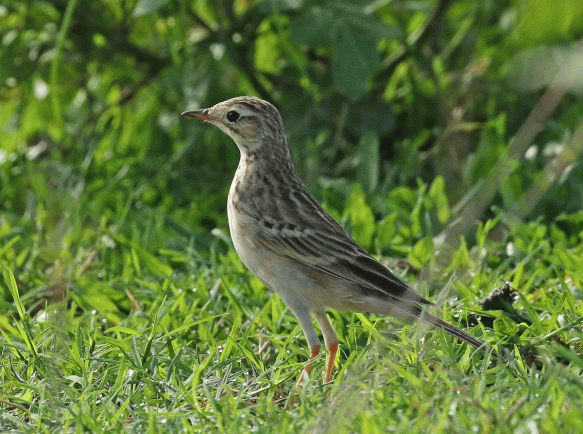
8) Structurally, Blyth’s Pipit looks slender and well-proportioned. The tail is longer than Paddyfield, but shorter than Richard’s.

9) The breast streaking is lighter than on typical Paddyfield, and 10) there is little or no contrast between the colour of the breast and belly. Photo credit: Ooi Beng Yean

At times, the ear coverts look slightly darker than the surrounding area, but are not nearly so dark and contrasting as on Paddyfield Pipit. The flanks have a distinctly peach-coloured wash and are unstreaked. Photo credit: Ooi Beng Yean

The pattern of the median coverts is distinctive. The central dark area is diamond-shaped, rather than triangular (as on Paddyfield and Richard’s), and the whitish edges are very clearly demarcated from the dark centres (on Paddyfield and Richard’s they blend into each other more smoothly, especially on the edges). Photo credit: Ooi Beng Yean
There’s lots more to learn about plumage variation in the larger pipits, so this is certainly not the last word on the matter, particularly as for the latter two species, my observations are limited to a small number of individuals.
Nevertheless, I hope this article will encourage you to take a closer look at pipits next time you have the opportunity to observe them, and that it will give you some idea of what you should be looking and listening out for.
A final plea – when you do positively identify pipits (or any other birds for that matter) – please do submit your observations to eBird Malaysia; doing so regularly will be of immense benefit in adding to our understanding of the true status of Malaysia’s beautiful birds.

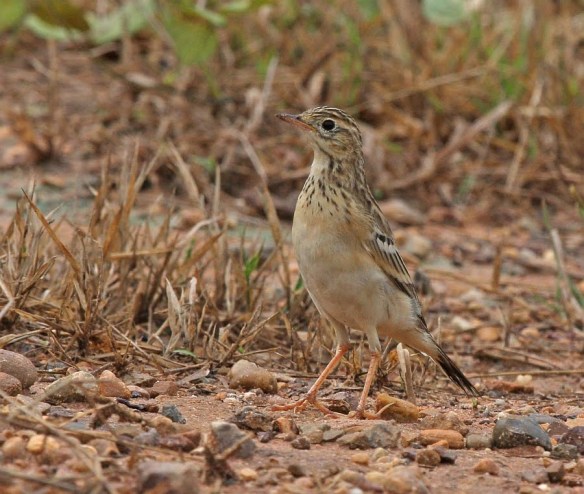


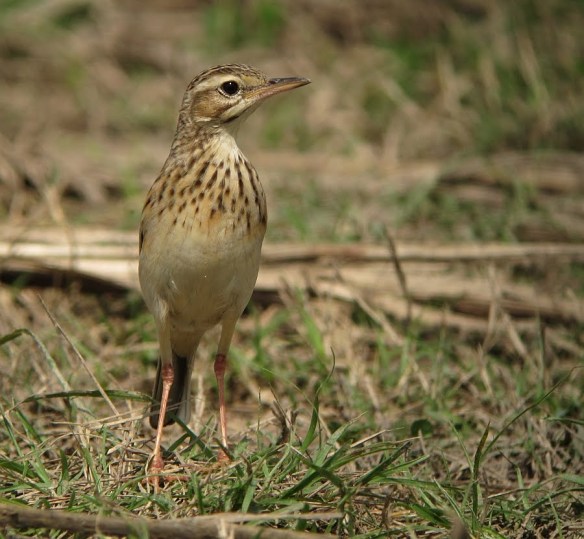

















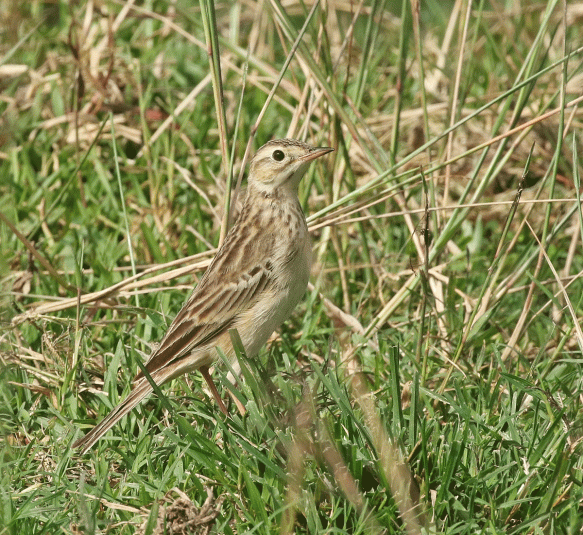


Excellent tips on identification of pipits.
So nice to see you blogging again, Dave.
Thanks Andrew, for the encouragement!
I sometimes see a couple at Shah Alam roundabout (Section 3) and one at the Cyberjaya Park. It’s hard to get a good look at these sleek fellas. 😅
As usual, Dave, I always enjoy reading your detailed posts on your blog. Many thanks for sharing one of this confusing birds..pipits! Next on the list, the swamphen? Btw, what tool did you use for your illustrations?
Hi Wendy, I use a Wacom Intuos tablet and Photoshop Elements. Thanks for the kind words!
Finally…!!!!! This Is the best site where I could come across the classification of the pipits. Thanks a ton for the very clear illustration and distinctive feature of the pipits. !!
Pingback: Pipit spec south Taiwan 13-02-18 – Belgium Birder in Taiwan
Beautiful work by very good clarity photos , illustrations and explanation of PIPITS ! Thank you . Happy to find people like you… good work. Regards, Shantha from Sri lanka
Pingback: Identifying Pipits: Blyth’s and Richard’s Pipits – Bird Count India